Обработка изображений, распознавание образов. Рубрика в журнале - Компьютерная оптика
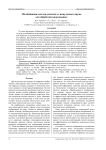
3D-обобщение метода очистки от импульсного шума для обработки видеоданных
Статья научная
В статье предложен обобщенный метод адаптивной медианной фильтрации импульсного шума для обработки видеоданных. Метод основан на совместном применении итеративной обработки и преобразования результата медианной фильтрации на основе распределения Лоренца. Предложены четыре различные комбинации алгоритмических блоков метода. В экспериментальной части статьи приведены результаты сравнения качества работы предложенного метода с известными аналогами. Для моделирования было использовано видео, искаженное импульсным шумом с вероятностями искажения пикселей от 1 % до 99 % включительно. Численная оценка качества очистки видеоданных от шума на основе среднеквадратичной ошибки и индекса структурного сходства показала, что предложенный метод показывает лучший результат обработки во всех рассмотренных случаях по сравнению с известными подходами. Полученные в статье результаты могут найти широкое применение в практических приложениях цифровой обработки видео, например, для обработки визуальных данных в системах видеонаблюдения, идентификации и контроля промышленных процессов.
Бесплатно
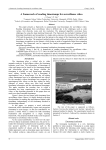
A framework of reading timestamps for surveillance video
Статья научная
This paper presents a framework to automatically read timestamps for surveillance video. Reading timestamps from surveillance video is difficult due to the challenges such as color variety, font diversity, noise, and low resolution. The proposed algorithm overcomes these challenges by using the deep learning framework. The framework has included: training of both timestamp localization and recognition in a single end-to-end pass, the structure of the recognition CNN and the geometry of its input layer that preserves the aspect of the timestamps and adapts its resolution to the data. The proposed method achieves state-of-the-art accuracy in the end-to-end timestamps recognition on our datasets, whilst being an order of magnitude faster than competing methods. The framework can be improved the market competitiveness of panoramic video surveillance products.
Бесплатно
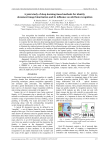
Статья научная
Text recognition has benefited considerably from deep learning research, as well as the preprocessing methods included in its workflow. Identity documents are critical in the field of document analysis and should be thoroughly researched in relation to this workflow. We propose to examine the link between deep learning-based binarization and recognition algorithms for this sort of documents on the MIDV-500 and MIDV-2020 datasets. We provide a series of experiments to illustrate the relation between the quality of the collected images with respect to the binarization results, as well as the influence of its output on final recognition performance. We show that deep learning-based binarization solutions are affected by the capture quality, which implies that they still need significant improvements. We also show that proper binarization results can improve the performance for many recognition methods. Our retrained U-Net-bin outperformed all other binarization methods, and the best result in recognition was obtained by Paddle Paddle OCR v2.
Бесплатно
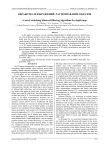
A novel switching bilateral filtering algorithm for depth map
Статья научная
In this paper, we propose a novel switching bilateral filter for depth map from a RGB-D sensor. The switching method works as follows: the bilateral filter is applied not at all pixels of the depth map, but only in those where noise and holes are possible, that is, at the boundaries and sharp changes. With the help of computer simulation we show that the proposed algorithm can effectively and fast process a depth map. The presented results show an improvement in the accuracy of 3D object reconstruction using the proposed depth filtering. The performance of the proposed algorithm is compared in terms of the accuracy of 3D object reconstruction and speed with that of common successful depth filtering algorithms.
Бесплатно
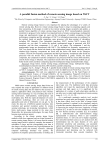
A parallel fusion method of remote sensing image based on NSCT
Статья научная
Remote sensing image fusion is very important for playing the advantages of a variety of remote sensing data. However, remote sensing image fusion is large in computing capacity and time consuming. In this paper, in order to fuse remote sensing images accurately and quickly, a parallel fusion algorithm of remote sensing image based on NSCT (nonsubsampled contourlet transform) is proposed. In the method, two important kinds of remote sensing image, multispectral image and panchromatic image are used, and the advantages of parallel computing in high performance computing and the advantages of NSCT in information processing are combined. In the method, based on parallel computing, some processes with large amount of calculation including IHS (Intensity, Hue, Saturation) transform, NSCT, inverse NSCT, inverse IHS transform, etc., are done. To realize the method, multispectral image is processed with IHS transform, and the three components, I, H, and S are gotten. The component I and the panchromatic image are decomposed with NSCT...
Бесплатно
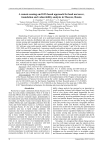
Статья научная
Monitoring of land use/cover (LULC) change is very important for sustainable development planning study. This research work is to understand natural and environmental situation and its cause such as intensity, distribution and socio and economic effects in Moscow, Russia based on remote sensing and Geographical Information System techniques. A model was developed by following thematic layers: land use/cover, vegetation, soil, geomorphology and geology in ArcGIS 10.2 software using multi-spectral satellite data obtained from Landsat 7 and 8 for the years of 1995, 2005 and 2016 respectively. Increasing scientific and political interest in regional aspects of global environmental changes, there is a strong stimulus to better understand the patterns causes and environmental consequences of LULC expansion in the elevation of Moscow state, one of the areas in the nation with fast economic growth and high population density. A 70 to 300 m inundation land loss scenarios for surface water and sea level rise (SLR) were developed using digital elevation models of study site topography through remote sensing and GIS techniques by ASTER GDEM and Landsat OLI data. The most severely impacted sectors are expected to be the vegetation, wetland and the natural ecosystem. Improved understanding of the extent and response of SLR will help in preparing for adaptation.
Бесплатно
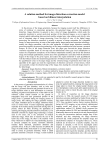
A solution method for image distortion correction model based on bilinear interpolation
Статья научная
In the process of the image generation, because the imaging system itself has differences in terms of nonlinear or cameraman perspective, the generated image will face the geometric distortion. Image distortion in general is also a kind of image degradation, which needs the geometric transform to correct each pixel position of the distorted images, so as to regain the original spatial relationships between pixels and the original grey value relation, and which is also one of important steps of image processing. From the point of view of the digital image processing, the distortion correction is actually a process of image restoration for a degraded image. In image processing, in terms of the image quality improvement and correction technology, namely the image restoration, with the wide expansion of digital image distortion correction processing applied, the processing technology of the image restoration has also become a research hotspot. In view of the image distortion issue, this paper puts forward the image distortion correction algorithm based on two-step and one-dimensional linear gray level interpolation to reduce the computation complexity of the bilinear interpolation method, and divide the distorted image into multiple quadrilaterals, and the area of the quadrilateral is associated with the distortion degree of the image in the given region, and express the region distortion of each quadrilateral with the bilinear model, thus determining parameters of bilinear model according to the position of the quadrilateral vertex in the target image and the distorted image...
Бесплатно
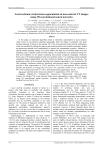
Статья научная
In this paper, an automatic algorithm aimed at volumetric segmentation of acute ischemic stroke lesion in non-contrast computed tomography brain 3D images is proposed. Our deep-learning approach is based on the popular 3D U-Net convolutional neural network architecture, which was modified by adding the squeeze-and-excitation blocks and residual connections. Robust pre-processing methods were implemented to improve the segmentation accuracy. Moreover, a special patches sampling strategy was used to address the large size of medical images and class imbalance and to stabilize neural network training. All experiments were performed using five-fold cross-validation on the dataset containing non-contrast computed tomography volumetric brain scans of 81 patients diagnosed with acute ischemic stroke. Two radiology experts manually segmented images independently and then verified the labeling results for inconsistencies. The quantitative results of the proposed algorithm and obtained segmentation were measured by the Dice similarity coefficient, sensitivity, specificity and precision metrics. The suggested pipeline provides a Dice improvement of 12.0 %, sensitivity of 10.2 % and precision 10.0 % over the baseline and achieves an average Dice of 62.8 ± 3.3 %, sensitivity of 69.9 ± 3.9 %, specificity of 99.7 ± 0.2 % and precision of 61.9 ± 3.6 %, showing promising segmentation results.
Бесплатно
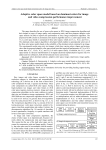
Статья научная
This paper describes the use of some color spaces in JPEG image compression algorithm and their impact in terms of image quality and compression ratio, and then proposes adaptive color space models (ACSM) to improve the performance of lossy image compression algorithm. The proposed ACSM consists of, dominant color analysis algorithm and YCoCg color space family. The YCoCg color space family is composed of three color spaces, which are YCcCr, YCpCg and YCyCb . The dominant colors analysis algorithm is developed which enables to automatically select one of the three color space models based on the suitability of the dominant colors contained in an image. The experimental results using sixty test images, which have varying colors, shapes and textures, show that the proposed adaptive color space model provides improved performance of 3 % to 10 % better than YCbCr, YDbDr, YCoCg and YCgCo-R color spaces family. In addition, the YCoCg color space family is a discrete transformation so its digital electronic implementation requires only two adders and two subtractors, both for forward and inverse conversions.
Бесплатно
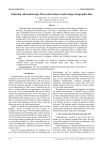
Adjusting videoendoscopic 3D reconstruction results using tomographic data
Статья научная
Videoendoscopic and tomographic research are the two leading medical imaging solutions for detecting, classifying and characterizing a wide array of pathologies and conditions. However, source information from these types of research is very different, making it hard to cross-correlate them. The paper proposes a novel algorithm for combining results of videoendoscopic and tomographic imaging data based on 3D surface reconstruction methods. This approach allows to align separate parts of two input 3D surfaces: surface obtained by applying bundle adjustment-based 3D surface reconstruction algorithm to the endoscopic video sequence, and surface reconstructed directly from separate tomographic cross-section slice projections with regular density. Proposed alignment method is based on using local feature extractor and descriptor algorithms by applying them to the source surface normal maps. This alignment allows both surfaces to be equalized and normalized relative to each other. Results show that such an adjustment allows to reduce noise, correct reconstruction artifacts and errors, increase representative quality of the resulting model and establish correctness of the reconstruction for hyperparameter tuning.
Бесплатно
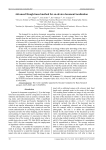
Advanced Hough-based method for on-device document localization
Статья научная
The demand for on-device document recognition systems increases in conjunction with the emergence of more strict privacy and security requirements. In such systems, there is no data transfer from the end device to a third-party information processing servers. The response time is vital to the user experience of on-device document recognition. Combined with the unavailability of discrete GPUs, powerful CPUs, or a large RAM capacity on consumer-grade end devices such as smartphones, the time limitations put significant constraints on the computational complexity of the applied algorithms for on-device execution. In this work, we consider document location in an image without prior knowledge of the document content or its internal structure. In accordance with the published works, at least 5 systems offer solutions for on-device document location. All these systems use a location method which can be considered Hough-based. The precision of such systems seems to be lower than that of the state-of-the-art solutions which were not designed to account for the limited computational resources. We propose an advanced Hough-based method. In contrast with other approaches, it accounts for the geometric invariants of the central projection model and combines both edge and color features for document boundary detection. The proposed method allowed for the second best result for SmartDoc dataset in terms of precision, surpassed by U-net like neural network. When evaluated on a more challenging MIDV-500 dataset, the proposed algorithm guaranteed the best precision compared to published methods. Our method retained the applicability to on-device computations.
Бесплатно
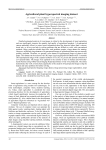
Agricultural plant hyperspectral imaging dataset
Статья научная
Detailed automated analysis of crop images is critical to the development of smart agriculture and can significantly improve the quantity and quality of agricultural products. A hyperspectral camera potentially allows to extract more information about the observed object than a conventional one, so its use can help in solving problems that are difficult to solve with conventional methods. Often, predictive models that solve such problems require a large dataset for training. However, sufficiently large datasets of hyperspectral images of agricultural plants are not currently publicly available. Therefore, we present a new dataset of hyperspectral images of plants in this paper. This dataset can be accessed via URL https://pypi.org/project/HSI-Dataset-API/. It contains 385 hyperspectral images with a spatial resolution of 512 by 512 pixels and spectral resolution of 237 spectral bands. The images were captured in the summer of 2021 in Samara and Novocherkassk (Russia) using Offner based Imaging Hyperspectrometer of our own production. The article demonstrates the work of some basic approaches to the analysis of hyperspectral images using the dataset and states problems for further solving.
Бесплатно
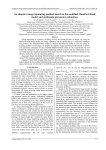
Статья научная
Image inpainting is a process of filling missing and damaged parts of image. By using the Mumford-Shah image model, the image inpainting can be formulated as a constrained optimization problem. The Mumford-Shah model is a famous and effective model to solve the image inpainting problem. In this paper, we propose an adaptive image inpainting method based on multiscale parameter estimation for the modified Mumford-Shah model. In the experiments, we will handle the comparison with other similar inpainting methods to prove that the combination of classic model such the modified Mumford-Shah model and the multiscale parameter estimation is an effective method to solve the inpainting problem.
Бесплатно
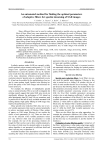
Статья научная
Many different filters can be used to reduce multiplicative speckle noise on radar images. Most of these filters have some parameters whose values influence the result of filtering. Finding optimal values of such parameters may be a non-trivial task. In this paper, a formal automated method for finding optimal parameters of speckle noise reduction filters is proposed. Using a specially designed test image, optimal parameters for the most commonly used filters were found using several image quality assessment metrics, including the Structural Similarity Index (SSIM) and Gradient Magnitude Similarity Deviation (GMSD). The use of filters with optimal parameters allows processing (detection, segmentation, etc.) of radar images with minimal influence of speckle noise.
Бесплатно
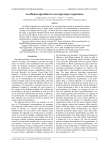
An efficient algorithm for non-rigid object registration
Статья научная
An efficient algorithm for registration of two non-rigid objects based on geometrical transformation of the template object to target object is proposed. The transformation is considered as warping of the template onto the target. To choose the most suitable transformation from all possible warps, a registration algorithm should satisfy deformation constraints referred to as regularization of non-rigid objects. In this work, we use variational functionals for affine transformations. With the help of computer simulation, the proposed method for searching the optimal geometrical transformation is compared with that of common algorithms.
Бесплатно
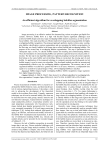
An efficient algorithm for overlapping bubbles segmentation
Статья научная
Image processing is an effective method for characterizing various two-phase gas/liquid flow systems. However, bubbly flows at a high void fraction impose significant challenges such as diverse bubble shapes and sizes, large overlapping bubble clusters occurrence, as well as out-of-focus bubbles. This study describes an efficient multi-level image processing algorithm for highly overlapping bubbles recognition. The proposed approach performs mainly in three steps: overlapping bubbles classification, contour segmentation and arcs grouping for bubble reconstruction. In the first step, we classify bubbles in the image into a solitary bubble and overlapping bubbles. The purpose of the second step is overlapping bubbles segmentation. This step is performed in two subsequent steps: at first, we classify bubble clusters into touching and communicating bubbles. Then, the boundaries of communicating bubbles are split into segments based on concave point extraction. The last step in our algorithm addresses segments grouping to merge all contour segments that belong to the same bubble and circle/ellipse fitting to reconstruct the missing part of each bubble. An application of the proposed technique to computer generated and high-speed real air bubble images is used to assess our algorithm. The developed method provides an accurate and computationally effective way for overlapping bubbles segmentation. The accuracy rate of well segmented bubbles we achieved is greater than 90 % in all cases. Moreover, a computation time equal to 12 seconds for a typical image (1 Mpx, 150 overlapping bubbles) is reached.
Бесплатно
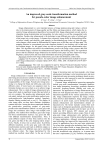
An improved gray-scale transformation method for pseudo-color image enhancement
Статья научная
Image enhancement is a very important process of image preprocessing and it plays a critical role in the improvement of image quality and the follow-up image analysis, which makes the research of image enhancement algorithm a hot research field. Image enhancement not only needs to strengthen image determination and recognition, but also needs to avoid the consequential color distortion. Pseudo-color enhancement is the technique to map different gray scales of a black-and-white image into a color image. As humans have extremely strong ability in distinguishing different colors visually and relatively weak capacity in discriminating gray scales, so, color the gray-scale changes which cannot be differentiated by human eyes so that they can tell them apart. The mapping function in conventional gray-scale transform method is not working well in dark and low-contrast images. So, this paper comes up with an improved gray-scale transformation algorithm. This algorithm can achieve the enhancement, preserve the image colors, process dark and low-contrast images, reinforce the enhancement and improve the blocking effect. The experiment proves that the enhanced image obtained by the method of this paper can have improved average brightness, natural colors and more detail information and it has good application value.
Бесплатно
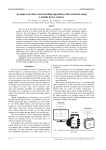
An improved video watermarking algorithm with extraction using a mobile device camera
Статья научная
The use of screen-capture-resistant digital watermarks is a promising way to store information invisibly in a video stream for later retrieval by the user using a smartphone camera. However, the development of algorithms that implement this scenario is associated with the problem of balancing between the imperceptibility of embedding and robustness. A serious problem is the extraction of watermarks using a mobile device. Most people use the vertical positioning of the smartphone when shooting, which excludes the possibility of only marked video sequences entering the frame. The extraction algorithm first finds the screen area in the image and then extracts the watermark under various distortion conditions. This study proposes an approach to improve the efficiency of the algorithm for embedding digital watermarks into video data based on rectangular patterns, which provides resistance to screen shooting. The proposed approach to increasing the embedding imperceptibility provided an increase in the PSNR and SSIM values by 17.18 % and 7.90 %, respectively. The use of a neural network at the extraction stage reduced the BER value by 64.64 %.
Бесплатно
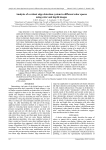
Analysis of a robust edge detection system in different color spaces using color and depth images
Статья научная
Edge detection is very important technique to reveal significant areas in the digital image, which could aids the feature extraction techniques. In fact it is possible to remove un-necessary parts from image, using edge detection. A lot of edge detection techniques has been made already, but we propose a robust evolutionary based system to extract the vital parts of the image. System is based on a lot of pre and post-processing techniques such as filters and morphological operations, and applying modified Ant Colony Optimization edge detection method to the image. The main goal is to test the system on different color spaces, and calculate the system’s performance. Another novel aspect of the research is using depth images along with color ones, which depth data is acquired by Kinect V.2 in validation part, to understand edge detection concept better in depth data. System is going to be tested with 10 benchmark test images for color and 5 images for depth format, and validate using 7 Image Quality Assessment factors such as Peak Signal-to-Noise Ratio, Mean Squared Error, Structural Similarity and more (mostly related to edges) for prove, in different color spaces and compared with other famous edge detection methods in same condition...
Бесплатно
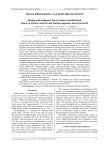
Статья научная
Breast cancer is a leading cause of death in women due to cancer. According to WHO, in 2018, it is estimated that 627.000 women died from breast cancer, that is approximately 15 % of all cancer deaths among women [3]. Early detection is a very important factor to reduce mortality by 25 - 30 %. Mammography is the most commonly used technique in detecting breast cancer using a low-dose X-ray system in the examination of breast tissue that can reduce false positives. A Computer-Aided Detection (CAD) system has been developed to effectively assist radiologists in detecting masses on mammograms that indicate the presence of breast tumors. The type of abnormality in mammogram images can be seen from the presence of microcalcifications and the presence of mass lesions. In this research, a new approach was developed to improve the performance of CAD System for classifying benign and malignant tumors. Areas suspected of being masses (RoI) in mammogram images were detected using an adaptive thresholding method and mathematical morphological operations. Wavelet decomposition is performed on the Region of Interest (RoI) and the feature extraction process is performed using a GLCM method with 4 statistical features, namely, contrast, correlation, entropy, and homogeneity. Classification of benign and malignant tumors using the MIAS database provided an accuracy of 95.83 % with a sensitivity of 95.23 % and a specificity of 96.49 %. A comparison with other methods illustrates that the proposed method provides better performance.
Бесплатно

